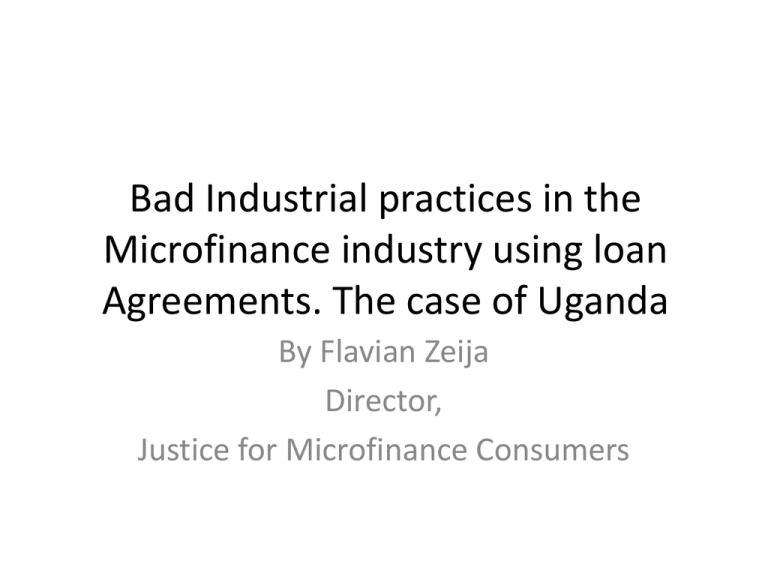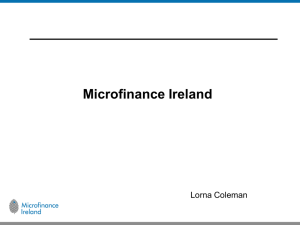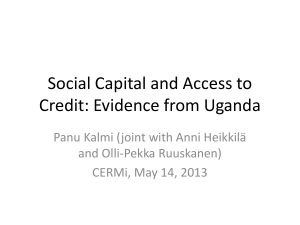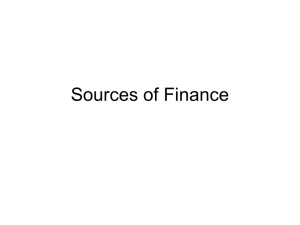Bad Industrial practices of MFI in Ugands - e-MFP
advertisement

Bad Industrial practices in the Microfinance industry using loan Agreements. The case of Uganda By Flavian Zeija Director, Justice for Microfinance Consumers A story in the Government Dairy Newspaper-The New Vision • Tuesday, 21st June, 2011 53 stuck in Luzira over money lenders; by Raymond Baguma OVER 50 inmates stuck in Luzira Prison over failure to pay civil debts have petitioned Chief Justice Benjamin Odoki to probe alleged corruption by magistrates and court bailiffs. The petitioners said the corrupt magistrates are found in Mengo, Nakawa, Mwanga II and Makindye courts. They also said they are ready to name and shame the corrupt court officers and bailiffs. The spokesperson of the judiciary, Elias Kisawuzi, yesterday confirmed receipt of the petition and said Odoki had instituted an investigation to be headed by the chief registrar, Henry Adonyo. Story Cont.. • The civil debtors in the petition said: “We bring to your attention the illegal mafia-like syndicate and connivance between magistrates, court clerks, lawyers and court bailiffs, who have turned the above-mentioned courts into money-minting machines for selfish interests at the detriment of litigants who are no longer accorded the right to fair hearing and trial as provided for in the constitution.” • The petitioners said they were not served with court summons to defend themselves on soft loans offered by money lenders and banks against post-dated cheques and loan agreements. Industrial Practices of MFI • Some Microfinance Companies defrauding clients -In December 2007, the Support Organisation for Microfinance Development (SOMED), a rural based Microfinance institution closed its doors and the directors disappeared • A story that appeared in the Microcapital Monitor 2007, read “Ugandan Police are investigating four savings and co-operative credit organizations (SACCOs) suspected of fraud. (Front Page Microfinance, Faster Micro Finance, Savings and Credit Cooperative Society Support Uganda Finance Limited and Stade Rugando Finance), all based in Kampala-refusing clients to withdraw their savings • Receiving insufficient loan funds, and sometimes the institutions keeping loan cash collateral yet clients pay interest on full amount • Interest calculated on Flat rate instead of reduced balance method and changing interest rates without client’s consent • High interest rates that sometimes goes beyond 100% in a year Challenges Cont.. • • • • • • • • Information Gap to Clients: Clients informed of the advantages of obtaining the loans but had not been informed of the underlying pitfalls related to the repayment of these loans. the loans officers do not explain to clients the effect of the loan documents they sign Information gap to Guarantors: Guarantors not appreciating that they are as liable as the principal debtor Hidden costs that are not explained to clients before taking up the loan Multiple borrowing to clear loans of other institutions without clear benefit Failure to appreciate the contents of the loan agreements by both loan officer and client. Many clients only ask for a space where to sign. Loan agreements drawn by lawyers without the intervention of local counsel Refusal to allow clients to redeem their loans before paying a certain number of instalments(Usually half way the loan) Attachment of properties without recourse to court The above issues present challenges for the continued survival of the industry.











